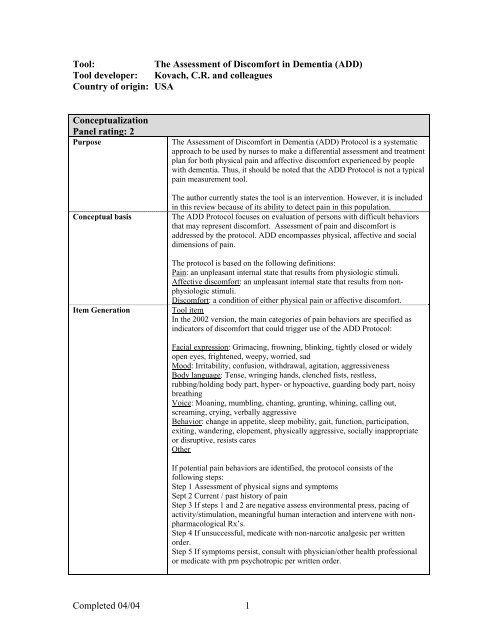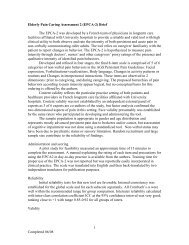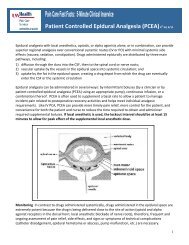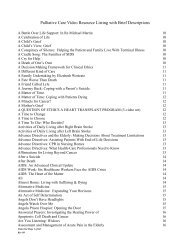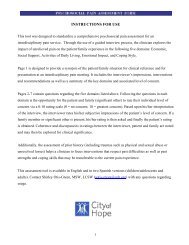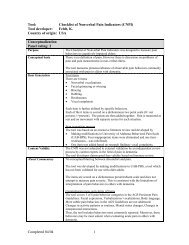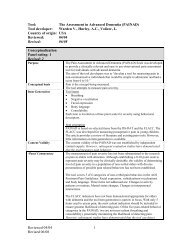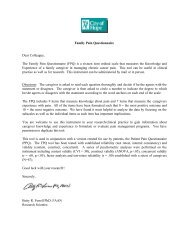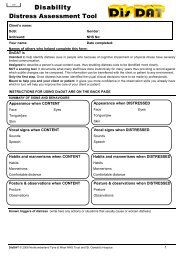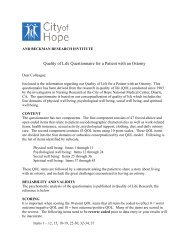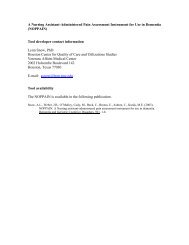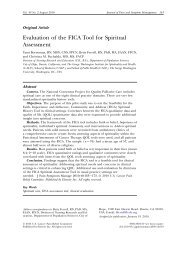The Assessment of Discomfort in Dementia (ADD)
The Assessment of Discomfort in Dementia (ADD)
The Assessment of Discomfort in Dementia (ADD)
You also want an ePaper? Increase the reach of your titles
YUMPU automatically turns print PDFs into web optimized ePapers that Google loves.
Tool:<br />
<strong>The</strong> <strong>Assessment</strong> <strong>of</strong> <strong>Discomfort</strong> <strong>in</strong> <strong>Dementia</strong> (<strong>ADD</strong>)<br />
Tool developer: Kovach, C.R. and colleagues<br />
Country <strong>of</strong> orig<strong>in</strong>: USA<br />
Conceptualization<br />
Panel rat<strong>in</strong>g: 2<br />
Purpose<br />
Conceptual basis<br />
Item Generation<br />
<strong>The</strong> <strong>Assessment</strong> <strong>of</strong> <strong>Discomfort</strong> <strong>in</strong> <strong>Dementia</strong> (<strong>ADD</strong>) Protocol is a systematic<br />
approach to be used by nurses to make a differential assessment and treatment<br />
plan for both physical pa<strong>in</strong> and affective discomfort experienced by people<br />
with dementia. Thus, it should be noted that the <strong>ADD</strong> Protocol is not a typical<br />
pa<strong>in</strong> measurement tool.<br />
<strong>The</strong> author currently states the tool is an <strong>in</strong>tervention. However, it is <strong>in</strong>cluded<br />
<strong>in</strong> this review because <strong>of</strong> its ability to detect pa<strong>in</strong> <strong>in</strong> this population.<br />
<strong>The</strong> <strong>ADD</strong> Protocol focuses on evaluation <strong>of</strong> persons with difficult behaviors<br />
that may represent discomfort. <strong>Assessment</strong> <strong>of</strong> pa<strong>in</strong> and discomfort is<br />
addressed by the protocol. <strong>ADD</strong> encompasses physical, affective and social<br />
dimensions <strong>of</strong> pa<strong>in</strong>.<br />
<strong>The</strong> protocol is based on the follow<strong>in</strong>g def<strong>in</strong>itions:<br />
Pa<strong>in</strong>: an unpleasant <strong>in</strong>ternal state that results from physiologic stimuli.<br />
Affective discomfort: an unpleasant <strong>in</strong>ternal state that results from nonphysiologic<br />
stimuli.<br />
<strong>Discomfort</strong>: a condition <strong>of</strong> either physical pa<strong>in</strong> or affective discomfort.<br />
Tool item<br />
In the 2002 version, the ma<strong>in</strong> categories <strong>of</strong> pa<strong>in</strong> behaviors are specified as<br />
<strong>in</strong>dicators <strong>of</strong> discomfort that could trigger use <strong>of</strong> the <strong>ADD</strong> Protocol:<br />
Facial expression: Grimac<strong>in</strong>g, frown<strong>in</strong>g, bl<strong>in</strong>k<strong>in</strong>g, tightly closed or widely<br />
open eyes, frightened, weepy, worried, sad<br />
Mood: Irritability, confusion, withdrawal, agitation, aggressiveness<br />
Body language: Tense, wr<strong>in</strong>g<strong>in</strong>g hands, clenched fists, restless,<br />
rubb<strong>in</strong>g/hold<strong>in</strong>g body part, hyper- or hypoactive, guard<strong>in</strong>g body part, noisy<br />
breath<strong>in</strong>g<br />
Voice: Moan<strong>in</strong>g, mumbl<strong>in</strong>g, chant<strong>in</strong>g, grunt<strong>in</strong>g, wh<strong>in</strong><strong>in</strong>g, call<strong>in</strong>g out,<br />
scream<strong>in</strong>g, cry<strong>in</strong>g, verbally aggressive<br />
Behavior: change <strong>in</strong> appetite, sleep mobility, gait, function, participation,<br />
exit<strong>in</strong>g, wander<strong>in</strong>g, elopement, physically aggressive, socially <strong>in</strong>appropriate<br />
or disruptive, resists cares<br />
Other<br />
If potential pa<strong>in</strong> behaviors are identified, the protocol consists <strong>of</strong> the<br />
follow<strong>in</strong>g steps:<br />
Step 1 <strong>Assessment</strong> <strong>of</strong> physical signs and symptoms<br />
Sept 2 Current / past history <strong>of</strong> pa<strong>in</strong><br />
Step 3 If steps 1 and 2 are negative assess environmental press, pac<strong>in</strong>g <strong>of</strong><br />
activity/stimulation, mean<strong>in</strong>gful human <strong>in</strong>teraction and <strong>in</strong>tervene with nonpharmacological<br />
Rx’s.<br />
Step 4 If unsuccessful, medicate with non-narcotic analgesic per written<br />
order.<br />
Step 5 If symptoms persist, consult with physician/other health pr<strong>of</strong>essional<br />
or medicate with prn psychotropic per written order.<br />
Completed 04/04 1
A Guide for Common <strong>Assessment</strong> Parameters is provided to support step 1.<br />
<strong>The</strong> Protocol <strong>in</strong>cludes a list <strong>of</strong> non-pharmacologic comfort <strong>in</strong>terventions.<br />
<strong>The</strong> most recent update <strong>in</strong>cludes two alternative versions <strong>of</strong> the protocol, one<br />
for LTC and one for the acute care sett<strong>in</strong>g, however no evidence for use <strong>in</strong><br />
acute care is provided.<br />
Content Validity<br />
-Panel Commentary<br />
Item generation process<br />
<strong>The</strong> behavioral <strong>in</strong>dicators are based on an extensive literature review and on<br />
focus groups and <strong>in</strong>clude behaviors represent<strong>in</strong>g all 6 categories <strong>of</strong> persistent<br />
pa<strong>in</strong> behaviors <strong>in</strong> the AGS Persistent Pa<strong>in</strong> Guidel<strong>in</strong>es.<br />
<strong>The</strong> <strong>ADD</strong> Protocol was not subjected to external review by <strong>in</strong>dependent<br />
content experts <strong>in</strong> the field <strong>of</strong> pa<strong>in</strong> <strong>in</strong> dementia.<br />
<strong>The</strong> protocol attempts to differentiate between behavioral changes caused by<br />
affective discomfort and those related to pa<strong>in</strong>.<br />
Pa<strong>in</strong> and discomfort are viewed as a multidimensional construct with<br />
physical, affective and social dimensions. This is carried over <strong>in</strong> the items<br />
which cover all 6 pa<strong>in</strong> behavior categories <strong>in</strong> the AGS Persistent Pa<strong>in</strong><br />
Guidel<strong>in</strong>es. <strong>The</strong> potential pa<strong>in</strong> <strong>in</strong>dicators are comprehensive <strong>in</strong> scope.<br />
Identification <strong>of</strong> the non-verbal cues is the trigger for <strong>in</strong>itiation <strong>of</strong> the <strong>ADD</strong><br />
protocol. <strong>The</strong> non-verbal pa<strong>in</strong> behaviors are measured as present/absent.<br />
Thus, the tool does not attempt to measure pa<strong>in</strong> severity, which is consistent<br />
with the limitations <strong>of</strong> <strong>in</strong>terpretation <strong>of</strong> pa<strong>in</strong> behaviors <strong>in</strong> elders with<br />
dementia.<br />
Subjects<br />
Panel rat<strong>in</strong>g: 2<br />
Subjects<br />
-Panel Commentary<br />
<strong>The</strong> assessment is divided <strong>in</strong>to a step-by-step process. <strong>The</strong> protocol is unique<br />
<strong>in</strong> us<strong>in</strong>g <strong>in</strong>terventions (both non-pharmacological and as needed analgesics)<br />
as a part <strong>of</strong> the assessment process.<br />
Study 1 (1999)<br />
Sett<strong>in</strong>g: 32 long term care facilities<br />
Subjects: Convenience sample <strong>of</strong> 104 residents<br />
Average age: 85 years; Range: 46-100 years<br />
Most subjects had a diagnosis <strong>of</strong> <strong>Dementia</strong> Alzheimer Type, were unable to<br />
communicate unmet needs and exhibited signs or symptoms commonly<br />
<strong>in</strong>dicat<strong>in</strong>g the presence <strong>of</strong> physical pa<strong>in</strong> or affective discomfort.<br />
Study 2 (2001)<br />
Sett<strong>in</strong>g: 6 LTC facilities <strong>in</strong> a Midwestern city<br />
Subjects: A convenience sample <strong>of</strong> 143 subjects<br />
Average age: 86.65 years (±6.16), Range: 56-100 years<br />
Gender: 81% female and 19% male<br />
Caucasian sample<br />
Average length <strong>of</strong> stay <strong>in</strong> LTC: 39.12 months (1 to 220, ±35.07)<br />
Average MMSE score: 5.45 (±6.16), Range 0 – 20.<br />
Focus on long term care sett<strong>in</strong>g is clearly identified. <strong>The</strong> number <strong>of</strong> facilities<br />
may be excessive especially <strong>in</strong> study I which opens for wide variability <strong>of</strong><br />
results. Limit<strong>in</strong>g number <strong>of</strong> facilities to 6 <strong>in</strong> study 2 may decrease variability.<br />
Sample <strong>in</strong> study 1 does not <strong>in</strong>dicate method <strong>of</strong> determ<strong>in</strong><strong>in</strong>g severity <strong>of</strong><br />
Completed 04/04 2
cognitive impairment.<br />
Subject gender is not specified <strong>in</strong> study 1. In study 2 there is limited male<br />
representation.<br />
<strong>The</strong>re is no <strong>in</strong>formation on ethnic/racial diversity for study 1. In study 2 the<br />
sample is limited to Caucasians.<br />
<strong>The</strong> sample <strong>in</strong> study 2 utilizes the MMSE which is an appropriate tool for<br />
screen<strong>in</strong>g for dementia.<br />
Given the nature <strong>of</strong> the protocol, it is not possible to evaluate sample size<br />
adequacy.<br />
Adm<strong>in</strong>istration, Scor<strong>in</strong>g, Feasibility<br />
Panel rat<strong>in</strong>g: 2<br />
Adm<strong>in</strong>istration,<br />
Scor<strong>in</strong>g,<br />
Feasibility<br />
For an overview <strong>of</strong> tool items, see “item generation” above.<br />
Tool developers <strong>in</strong>dicate that systematic assessment <strong>of</strong> behavioral<br />
symptomatology would occur on admission to LTC, at quarterly reviews,<br />
through daily monitor<strong>in</strong>g and at meet<strong>in</strong>gs to review resident behaviors.<br />
Several triggers that may elicit ongo<strong>in</strong>g monitor<strong>in</strong>g <strong>of</strong> behaviors are <strong>in</strong>dicated<br />
<strong>in</strong>clud<strong>in</strong>g:<br />
• Cod<strong>in</strong>g on the M<strong>in</strong>imum Data Set<br />
• Systematic assessment <strong>of</strong> behavioral symptomatology.<br />
A Guide for Common <strong>Assessment</strong> Parameters is provided to support step 1.<br />
Moreover, the protocol <strong>in</strong>cludes a list <strong>of</strong> non-pharmacologic comfort<br />
<strong>in</strong>terventions.<br />
Prelim<strong>in</strong>ary test<strong>in</strong>g <strong>of</strong> the <strong>ADD</strong> Protocol was conducted <strong>in</strong> naturalistic<br />
sett<strong>in</strong>gs without controls. Implementation <strong>in</strong> practice was accompanied by<br />
extensive teach<strong>in</strong>g <strong>of</strong> nurses on how to use the protocol.<br />
-Panel Commentary<br />
Nurses completed questionnaires after implementation <strong>of</strong> the first version <strong>of</strong><br />
the <strong>ADD</strong> Protocol: 12% thought the protocol had no real impact, 44% found<br />
<strong>ADD</strong> somewhat helpful, 44% found it very helpful. Benefits <strong>of</strong> us<strong>in</strong>g the<br />
<strong>ADD</strong> <strong>in</strong>cluded <strong>in</strong>creased staff awareness <strong>of</strong> discomfort and improved<br />
assessments.<br />
Method <strong>of</strong> adm<strong>in</strong>istration is adequately described.<br />
Reliability<br />
Panel rat<strong>in</strong>g: 1<br />
Internal consistency<br />
“Scor<strong>in</strong>g procedures” are not applicable.<br />
Interpretation <strong>of</strong> assessment results at each step <strong>in</strong> the protocol relies heavily<br />
on cl<strong>in</strong>ical judgment.<br />
Cl<strong>in</strong>ical utility<br />
• Time: <strong>The</strong>re is no documentation <strong>of</strong> time <strong>in</strong>volved <strong>in</strong> us<strong>in</strong>g the <strong>ADD</strong><br />
Protocol. <strong>The</strong> protocol <strong>in</strong>volves multiple steps and extensive<br />
documentation to complete. This <strong>in</strong>dicates that a considerable amount <strong>of</strong><br />
time may be <strong>in</strong>volved <strong>in</strong> us<strong>in</strong>g the protocol.<br />
• Skill needed: <strong>The</strong> <strong>ADD</strong> Protocol <strong>in</strong>volves multiple steps and complex<br />
cl<strong>in</strong>ical decisions. Use <strong>of</strong> the protocol requires extensive education. No<br />
<strong>in</strong>formation on tra<strong>in</strong><strong>in</strong>g time or target user is provided.<br />
Internal consistency evaluation is not provided.<br />
Interrater reliability Study 1<br />
Four residents were assessed by two nurses.<br />
Completed 04/04 3
Test-retest reliability<br />
-Panel commentary<br />
Percent agreement<br />
For the total tool 86%<br />
For medication use: 100%<br />
For non-pharmacological <strong>in</strong>terventions: 76%<br />
<strong>Discomfort</strong><strong>in</strong>g symptomatology: 87%.<br />
Test-retest <strong>of</strong> the <strong>ADD</strong> Protocol has not been established<br />
Internal consistency<br />
Because <strong>of</strong> the nature <strong>of</strong> the protocol, evaluation <strong>of</strong> <strong>in</strong>ternal consistency may<br />
not be appropriate. However, the behavior checklist could and should be<br />
evaluated for <strong>in</strong>ternal consistency.<br />
Interrater reliability<br />
<strong>The</strong> sample size for establish<strong>in</strong>g <strong>in</strong>terrater reliability is too small for mak<strong>in</strong>g<br />
<strong>in</strong>ference.<br />
Although percent agreement between two raters was established for 4<br />
residents with good results, kappa statistic would be more appropriate.<br />
Test-retest reliability:<br />
Test-retest reliability test<strong>in</strong>g is appropriate, and is needed for evaluat<strong>in</strong>g<br />
persistent pa<strong>in</strong>.<br />
General<br />
No data on reliability <strong>in</strong> identification <strong>of</strong> pa<strong>in</strong> related behaviors used to<br />
trigger use <strong>of</strong> the protocol are provided.<br />
Validity: Criterion or construct<br />
Panel rat<strong>in</strong>g: 2<br />
Construct validity/<br />
Criterion related validity<br />
Predictive validity<br />
Study presented <strong>in</strong> Kovach et al., 1999. (see sample characteristics for study 1<br />
above).<br />
Behavioral assessment <strong>of</strong> discomfort<strong>in</strong>g symptomatology: 87%<br />
7 days prior to <strong>in</strong>stitut<strong>in</strong>g the <strong>ADD</strong> Protocol, the sample had an average <strong>of</strong><br />
32.85 (±16.78).behavioral symptoms associated with discomfort. Seven days<br />
follow<strong>in</strong>g <strong>ADD</strong> protocol, the sample had an average <strong>of</strong> 23.47 behaviors<br />
(±16.52). This represents a significant decrease <strong>in</strong> discomfort (t=6.56,<br />
p=0.000) and a significant <strong>in</strong>crease <strong>in</strong> use <strong>of</strong> pharmacologic (t=2.56, p=.012)<br />
and non-pharmacologic <strong>in</strong>terventions (t=3.37, p=.001).<br />
-Panel commentary<br />
<strong>The</strong> most frequently seen behavioral symptoms pre-<strong>in</strong>tervention were (listed<br />
by order <strong>of</strong> frequency): tense body language, sad facial expression, fidget<strong>in</strong>g,<br />
perseverant verbalizations, verbal outburst. <strong>The</strong>se were also prevalent post<strong>in</strong>tervention,<br />
however fidget<strong>in</strong>g was slightly more frequent than sad facial<br />
expression at post-<strong>in</strong>tervention. Further, the behavioral symptoms show<strong>in</strong>g<br />
the largest average changes at post-<strong>in</strong>tervention compared to pre-<strong>in</strong>tervention<br />
were tense body language and sad facial expression.<br />
<strong>The</strong> behavior changes reported are supportive <strong>in</strong> the expected direction;<br />
however, construct and/or criterion validity as would be established for<br />
traditional measurement tools has not been established with the <strong>ADD</strong><br />
Protocol to date.<br />
Completed 04/04 4
Summary <strong>of</strong> panel evaluation <strong>of</strong> pa<strong>in</strong> assessment tool<br />
<strong>The</strong> <strong>ADD</strong> Protocol provides a comprehensive approach to recognition <strong>of</strong> potential pa<strong>in</strong> conditions through<br />
observation and validation procedures that are conceptually sound. <strong>The</strong> tool addresses diverse potential pa<strong>in</strong><br />
<strong>in</strong>dicators <strong>in</strong> this population and uses an assessment validation approach that focuses on positive changes <strong>in</strong><br />
behavior. <strong>The</strong> behavior checklist is comprehensive. However, data are limited regard<strong>in</strong>g its reliability.<br />
Prelim<strong>in</strong>ary test<strong>in</strong>g <strong>of</strong> the protocol suggests its potential usefulness; however, additional test<strong>in</strong>g <strong>of</strong> reliability<br />
and validity is needed, particularly larger samples <strong>in</strong>clud<strong>in</strong>g m<strong>in</strong>ority subjects. <strong>The</strong> cl<strong>in</strong>ical utility is also<br />
unclear regard<strong>in</strong>g time for tra<strong>in</strong><strong>in</strong>g and time to complete the protocol. . Although the protocol is a complete<br />
approach to recognition <strong>of</strong> pa<strong>in</strong> <strong>in</strong> this population, it may be too complex for rout<strong>in</strong>e use and streaml<strong>in</strong><strong>in</strong>g <strong>of</strong><br />
the steps may be needed.<br />
Sources <strong>of</strong> evidence<br />
Kovach, C.R., Weissman, D.E., Griffie, J., Matson, S., Muchka, S. (1999). <strong>Assessment</strong> and treatment <strong>of</strong><br />
discomfort for people with late-stage dementia. Journal <strong>of</strong> Pa<strong>in</strong> and Symptom Management, 18(6),<br />
412-419.<br />
Kovach, C.R., Noonan, P.E., Griffie, J., Muchka, S., Weissman, D.E. (2001). Use <strong>of</strong> the <strong>Assessment</strong> <strong>of</strong><br />
<strong>Discomfort</strong> <strong>in</strong> <strong>Dementia</strong> Protocol. Applied Nurs<strong>in</strong>g Research, 14(4), 193-200.<br />
Kovach, C.R., Noonan, P.E., Griffie, J., Muchka, S., Weissman, D.E. (2002). <strong>The</strong> <strong>Assessment</strong> <strong>of</strong><br />
<strong>Discomfort</strong> <strong>in</strong> <strong>Dementia</strong> Protocol. Pa<strong>in</strong> Management Nurs<strong>in</strong>g, 3(1), 16-27.<br />
Contact address for tool developer:<br />
Christ<strong>in</strong>e R. Kovach, PhD, RN, FAAN ckovach@uwm.edu<br />
Key to panel rat<strong>in</strong>g<br />
3= Available evidence is strong<br />
2= Available evidence supports need for further test<strong>in</strong>g<br />
1= Available evidence is <strong>in</strong>sufficient and/or tool revisions are needed<br />
0= Evidence is absent<br />
Evaluation completed by:<br />
K. Herr, S. Decker, K. Bjoro, University <strong>of</strong> Iowa.<br />
Contact <strong>in</strong>formation: keela-herr@uiowa.edu<br />
Completed 04/04 5


